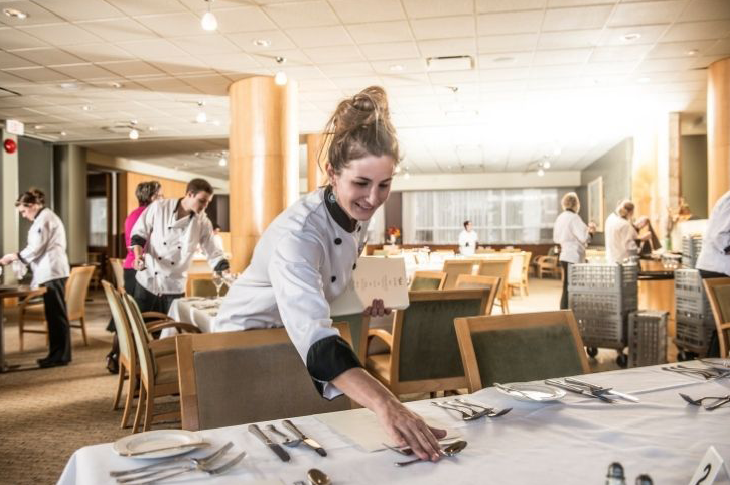SAIT’s new hospitality and tourism program offers flexibility and focus

The global COVID-19 pandemic affected industries around the world — few more so than hospitality and tourism. Now, with countries and organizations looking ahead to travel resuming and diners back in restaurants with no restrictions, the industry is preparing for a renaissance — and SAIT’s School of Hospitality and Tourism is ready to leverage that, unveiling program changes that will benefit students and industry alike.
Starting this fall, students in the Hospitality and Tourism Management diploma will begin their education with a general base of information before honing their skills in six specializations, such as hotel and accommodations, event management, travel and tourism, and entrepreneurship and innovation. It’s a change designed to increase graduates’ success as they move into their careers.
“These specializations will give students the extra advantage,” says School of Hospitality and Tourism instructor Mona James, adding the shift aligns with what’s happening in industry, and industry advisors unanimously supported the change.
“We have the ability to be more hands-on with the specializations, which is what SAIT is about too,” she says.
Responsive programming, created in consultation with industry to ensure market needs are met, is one of the many reasons SAIT’s School for Hospitality and Tourism has earned a spot on CEOWORLD Magazine’s list of the best hospitality and hotel management schools for the last six years — rising in the ranks each time. In 2021, SAIT climbed two spots to no. 19, while also earning the top spot for the magazine’s inaugural list of best culinary schools in Canada.
School of Hospitality and Tourism Dean James Overall, says the recognition reflects SAIT’s commitment to student success with programming that offers industry-relevant courses taught by experts in their fields.
“The changes to our programming for the fall are part of our commitment to ensure students have the knowledge and skills to be the industry leaders of tomorrow,” he says.
As part of the changes, students have more than 40 courses to choose from for the 22 needed to complete the diploma program, giving them unparalleled flexibility and choice when it comes to focusing their careers. The courses — in areas such as people, leadership and culture, guest experience and financial management — were created through comprehensive consultation with industry. More than 60 industry partners offered feedback through the process.
Overall says industry is looking for more adaptability and a guest-focused mindset — something the program will emphasize on even more than before.
The move to merge travel and hospitality from two separate programs to one that will be offered year-round, offers more options for students to pick up classes that fit their schedules and take on internships outside of traditional summer months. There are also increased opportunities for students to learn on the job thanks to new industry partnerships coming on board.
The merge also means, going forward, all students studying to obtain a diploma in hospitality and tourism management are eligible to continue on and earn their Bachelor of Hospitality and Tourism Management — something James says industry is looking for from new hires.
“We’re seeing a lot of demand for degrees.”
While changes were underway before the global COVID-19 pandemic hit, pent-up consumer demand will keep the tourism and hospitality industry busier than ever as restrictions start to lift.
And SAIT graduates will be ready to fill the employee gap, using their applied education and internship opportunities to hit the ground running.
Be part of the exciting and fast-paced industry of hospitality and tourism
From Hotel and Accommodations to Travel and Tourism - SAIT’s Hospitality and Tourism Management diploma can take your career from here to anywhere.
Learn moreIndustry Driven
We prepare students for successful careers and lives.
SAIT'S
2020-2025
Strategic plan

Oki, Âba wathtech, Danit'ada, Tawnshi, Hello.
SAIT is located on the traditional territories of the Niitsitapi (Blackfoot) and the people of Treaty 7 which includes the Siksika, the Piikani, the Kainai, the Tsuut’ina and the Îyârhe Nakoda of Bearspaw, Chiniki and Goodstoney.
We are situated in an area the Blackfoot tribes traditionally called Moh’kinsstis, where the Bow River meets the Elbow River. We now call it the city of Calgary, which is also home to the Métis Nation of Alberta.